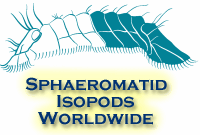| Abstract |
We examined the biogeography of three freshwater isopod species (Austridotea annectens, A. lacustris, A. benhami), and tested the hypotheses that genetic differences would: (1) exist between geographic locations; and (2) correspond to known geological events (e.g. appearance of islands leading to the availability of habitat). Location
Southern New Zealand, including South Island, Stewart Island, Campbell Island and Chatham Islands. Methods
We examined specimens throughout the known species range from 12 populations of A. lacustris, five populations of A. annectens, and three populations of A. benhami, using mitochondrial DNA (cytochrome c oxidase I) sequence analyses. Results
We resolved three main clades corresponding to the three species, with 16% sequence divergence between A. annectens and A. benhami, and 31% divergence between these species and A. lacustris. Divergence within A. benhami was <?2.0%. However, divergence within A. lacustris reached up to 10% with four main groupings: (1) Chatham Islands; (2) Campbell Island; (3) Fiordland; and (4) east coast South Island and Stewart Island. Divergence within A. annectens reached up to 4.4%, with two main groupings: (1) Chatham Islands and (2) east coast South Island and Stewart Island. Patterns of genetic divergence were most likely the result of geographical isolation among A. lacustris and A. annectens populations. In particular, the divergence of A. lacustris and A. annectens on Chatham Islands may correspond to the availability of this habitat c. 4?Ma, whereas the divergence of A. lacustris on the much older Campbell Island and in Fiordland may indicate either a rare founder event or a change in ocean circulation that resulted in their isolation from a once more widespread gene pool. Main conclusions
The three New Zealand species of Austridotea are genetically distinct, with up to 31% divergence between species. Genetic variability was highest between populations of the two most widely distributed species, and divergence was greatest on islands distant from mainland New Zealand and in the discrete Fiordland region. The magnitude of genetic divergence of isopods on the Auckland and Chatham Islands is consistent with these populations having been founded in the Pliocene via oceanic dispersal from mainland New Zealand.
Keywords: Austridotea; biogeography; Isopoda; mitochondrial DNA; New Zealand; Pliocene isolation |

















